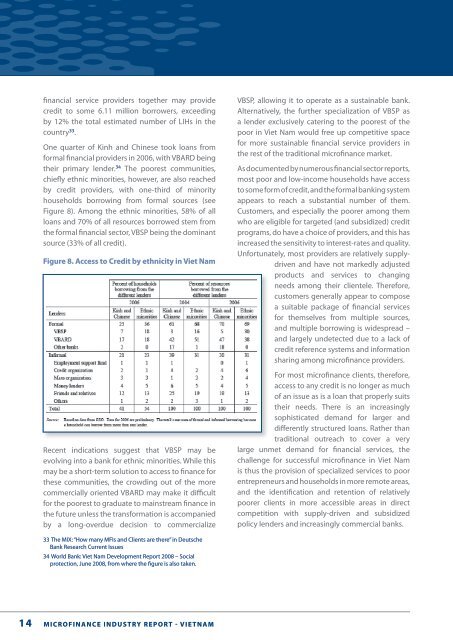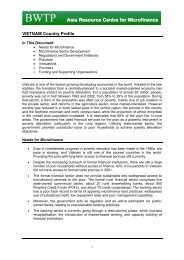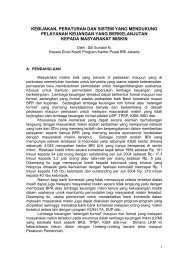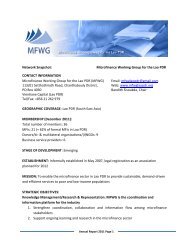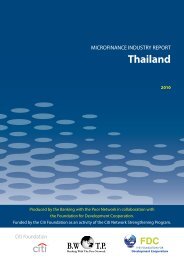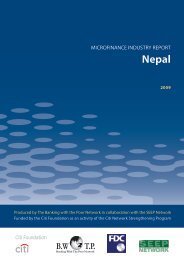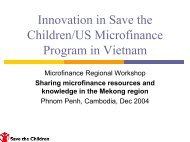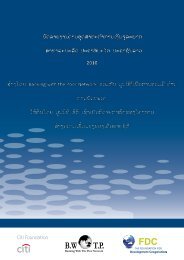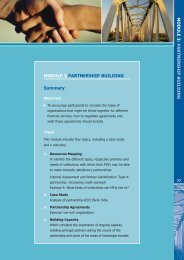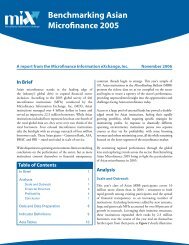microfinance industry report - Vietnam - Banking with the Poor Network
microfinance industry report - Vietnam - Banking with the Poor Network
microfinance industry report - Vietnam - Banking with the Poor Network
You also want an ePaper? Increase the reach of your titles
YUMPU automatically turns print PDFs into web optimized ePapers that Google loves.
financial service providers toge<strong>the</strong>r may provide<br />
credit to some 6.11 million borrowers, exceeding<br />
by 12% <strong>the</strong> total estimated number of LIHs in <strong>the</strong><br />
country 33 .<br />
One quarter of Kinh and Chinese took loans from<br />
formal financial providers in 2006, <strong>with</strong> VBARD being<br />
<strong>the</strong>ir primary lender. 34 The poorest communities,<br />
chiefly ethnic minorities, however, are also reached<br />
by credit providers, <strong>with</strong> one-third of minority<br />
households borrowing from formal sources (see<br />
Figure 8). Among <strong>the</strong> ethnic minorities, 58% of all<br />
loans and 70% of all resources borrowed stem from<br />
<strong>the</strong> formal financial sector, VBSP being <strong>the</strong> dominant<br />
source (33% of all credit).<br />
Figure 8. Access to Credit by ethnicity in Viet Nam<br />
Recent indications suggest that VBSP may be<br />
evolving into a bank for ethnic minorities. While this<br />
may be a short-term solution to access to finance for<br />
<strong>the</strong>se communities, <strong>the</strong> crowding out of <strong>the</strong> more<br />
commercially oriented VBARD may make it difficult<br />
for <strong>the</strong> poorest to graduate to mainstream finance in<br />
<strong>the</strong> future unless <strong>the</strong> transformation is accompanied<br />
by a long-overdue decision to commercialize<br />
VBSP, allowing it to operate as a sustainable bank.<br />
Alternatively, <strong>the</strong> fur<strong>the</strong>r specialization of VBSP as<br />
a lender exclusively catering to <strong>the</strong> poorest of <strong>the</strong><br />
poor in Viet Nam would free up competitive space<br />
for more sustainable financial service providers in<br />
<strong>the</strong> rest of <strong>the</strong> traditional <strong>microfinance</strong> market.<br />
As documented by numerous financial sector <strong>report</strong>s,<br />
most poor and low-income households have access<br />
to some form of credit, and <strong>the</strong> formal banking system<br />
appears to reach a substantial number of <strong>the</strong>m.<br />
Customers, and especially <strong>the</strong> poorer among <strong>the</strong>m<br />
who are eligible for targeted (and subsidized) credit<br />
programs, do have a choice of providers, and this has<br />
increased <strong>the</strong> sensitivity to interest-rates and quality.<br />
Unfortunately, most providers are relatively supplydriven<br />
and have not markedly adjusted<br />
products and services to changing<br />
needs among <strong>the</strong>ir clientele. Therefore,<br />
customers generally appear to compose<br />
a suitable package of financial services<br />
for <strong>the</strong>mselves from multiple sources,<br />
and multiple borrowing is widespread –<br />
and largely undetected due to a lack of<br />
credit reference systems and information<br />
sharing among <strong>microfinance</strong> providers.<br />
For most <strong>microfinance</strong> clients, <strong>the</strong>refore,<br />
access to any credit is no longer as much<br />
of an issue as is a loan that properly suits<br />
<strong>the</strong>ir needs. There is an increasingly<br />
sophisticated demand for larger and<br />
differently structured loans. Ra<strong>the</strong>r than<br />
traditional outreach to cover a very<br />
large unmet demand for financial services, <strong>the</strong><br />
challenge for successful <strong>microfinance</strong> in Viet Nam<br />
is thus <strong>the</strong> provision of specialized services to poor<br />
entrepreneurs and households in more remote areas,<br />
and <strong>the</strong> identification and retention of relatively<br />
poorer clients in more accessible areas in direct<br />
competition <strong>with</strong> supply-driven and subsidized<br />
policy lenders and increasingly commercial banks.<br />
33 The MIX: “How many MFIs and Clients are <strong>the</strong>re” in Deutsche<br />
Bank Research Current Issues<br />
34 World Bank: Viet Nam Development Report 2008 – Social<br />
protection, June 2008, from where <strong>the</strong> figure is also taken.<br />
14 <strong>microfinance</strong> <strong>industry</strong> <strong>report</strong> - vietnam<br />
<strong>Vietnam</strong>e_Report_FOR_PRINT.indd 14<br />
27/05/2009 7:46:01 PM


